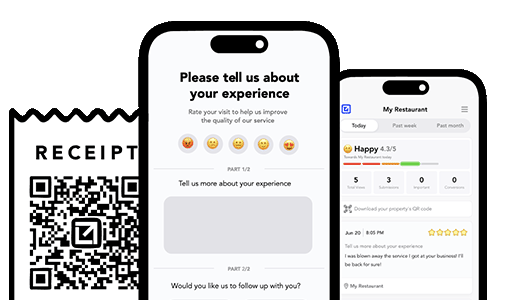Restaurant Marketing in 2025 [Guide]
How to market a restaurant in 2025 using modern strategies and tools.

TLDR: Where you place your QR code can make or break your feedback strategy. Restaurants using VisibleFeedback have several solid options, on receipts, at the register, even on takeout bags, but the most effective placement, hands down, is at the table. Table-level cards or placards let guests scan discreetly, while the experience is fresh. It removes pressure from staff presence, encourages honesty, and gives your team a chance to respond in real time before issues go public. This article breaks down common placement strategies, their pros and cons, and why table placement consistently drives higher volume and better quality feedback. Whether you’re running a café, fine dining spot, or fast casual joint, getting this right sets the tone for smarter service and better reviews.
You’ve done the hard part: you’ve set up a feedback system. Now the big question is, where do you ask for it? It seems like a small detail, but where you place your QR code will directly impact how often guests respond, how honest they are, and how actionable the feedback becomes. A poorly placed code won’t just lower your response rate, it could cost you the chance to catch issues before they go public. Visibility, timing, and privacy all matter. The goal isn’t just more feedback. It’s better feedback, from more of your real guests, while their experience is still fresh.
Putting a QR code on a printed receipt is common and low-effort. It’s easy to roll out, works for dine-in and takeout, and doesn’t clutter the table. The problem? It’s passive and easy to miss. Most guests glance at the total, toss the receipt, and never scan. Plus, the moment’s already passed. If they had a concern, they’ve likely left. There’s no window to fix the issue, no context for the tone, and no way to clarify. It’s not bad, but it’s not proactive either.
If you run a fast casual or counter-service concept, the checkout counter seems like a logical place. The guest is finishing their interaction, you’re right there, and it’s a natural point to ask. But that also makes it awkward. Few guests want to scan a feedback code with a staff member two feet away. It can feel performative or forced. That can skew results, or worse, reduce participation entirely. Most people won’t tell you the chicken was cold while you’re smiling at them. You’ll get polite responses or none at all.
Putting your QR code directly at the table is the single most effective strategy. Whether you’re fine dining or casual lunch, a small placard or tent card creates the perfect blend of visibility, privacy, and timing. The guest sees it while they’re still eating or just after finishing, when their impression is clearest. And because it doesn’t involve a staff member watching, it removes social pressure. That means more honesty. More details. More chances for you to catch a negative before it turns into a one-star Yelp review.
Here’s why table QR codes work so well:
It’s also easy to test. Start with a few tables and track your VisibleFeedback response rate. Chances are, you’ll see a spike in both volume and quality.
The placement isn’t the only factor, language matters too. Don’t just write “Feedback” or “Survey.” That feels formal and cold. Instead, try phrasing like:
Your goal is to make it inviting, not clinical. Bonus tip: let guests know feedback is reviewed daily and can earn them small perks (“Your comment might win a free dessert next visit”). It builds trust and reward.
Table placement is king, but other options can supplement it:
But again, if you can only do one thing, put it on the table. You’ll gather the most honest, useful insights when the food’s still warm and the mood is still set.
In 2025, reputation management doesn’t start online, it starts in the dining room. The best restaurants don’t just serve, they listen. By making feedback feel casual, immediate, and private, you show customers that you care while there’s still time to act.
Tools like VisibleFeedback take this even further. We route feedback in real time, surface potential problems before they explode, and guide happy guests toward public reviews where they matter most. But none of it works without the scan. That starts with smart placement.
So the next time you set a table, don’t just think forks and napkins. Think feedback, too.

Bad reviews can scare away potential customers. Intercept feedback in real time with VisibleFeedback.

Austin Spaeth is the founder of VisibleFeedback, a simple tool that helps brick-and-mortar businesses intercept negative reviews before they go public. With a background in software development and a passion for improving customer experience, Austin built VisibleFeedback to give business owners a frictionless way to collect private feedback and turn unhappy visitors into loyal advocates. When he’s not working on new features or writing about reputation strategy, he’s probably wrangling one of his six kids or sneaking in a beach day.
Whether you have no reviews, bad ones, or great ones, we’ll help you turn your feedback into growth.
No credit card required.
⛨ Trusted by over 137 local businesses like yours